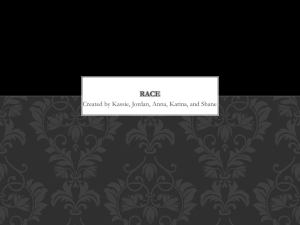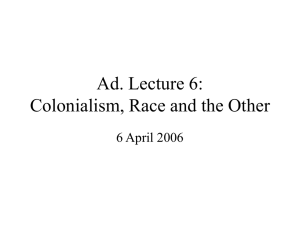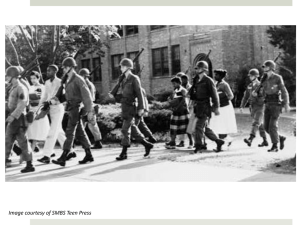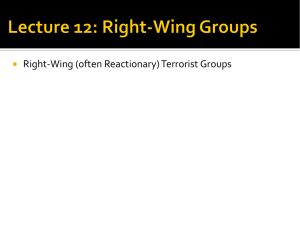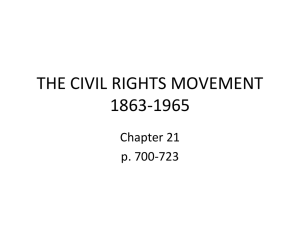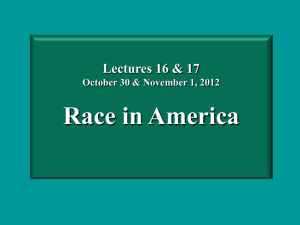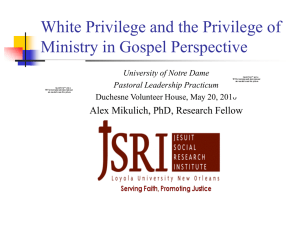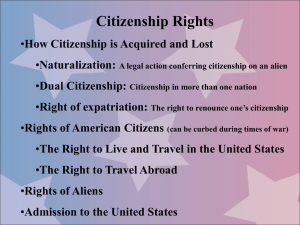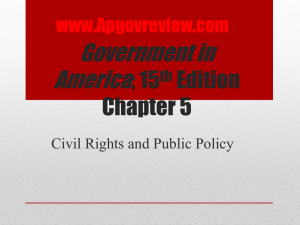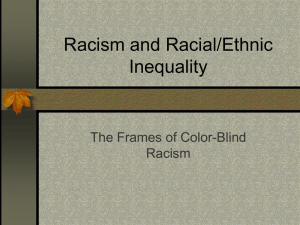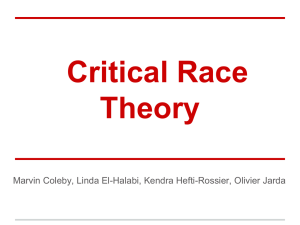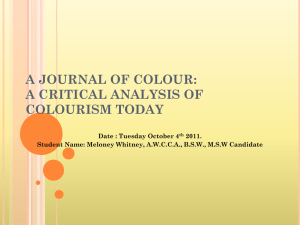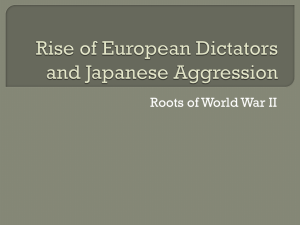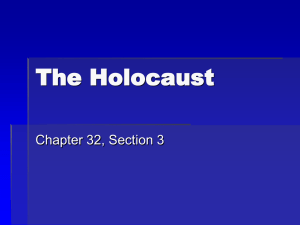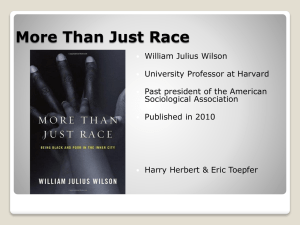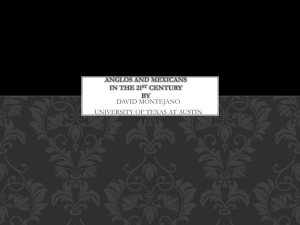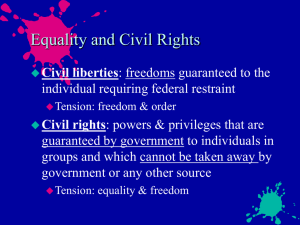Jessica – Racism
advertisement
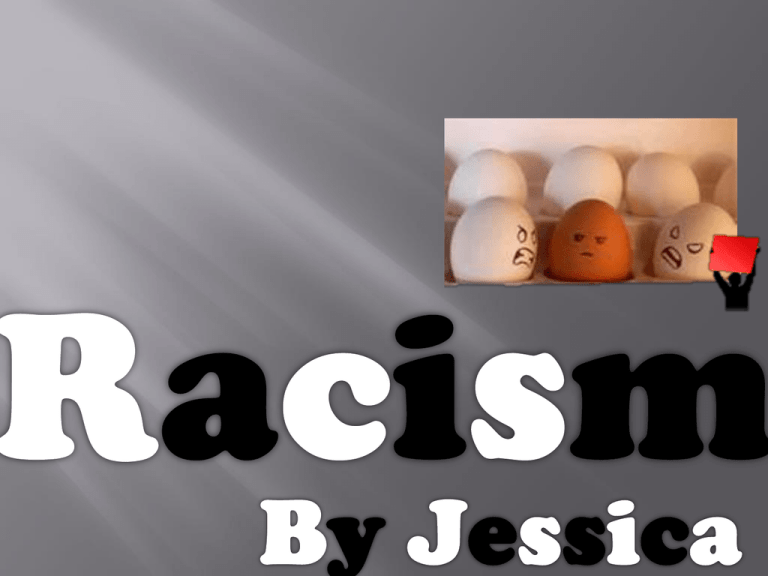
Dictionary definition: 1. The belief that race accounts for differences in human character or ability and that a particular race is superior to others. 2. Discrimination or prejudice based on race. In the 19th century scientists believed the humans were separated into different races, it was often believed that some races were more inferior to others and that different treatment was appropriate. Racism involves belief in different racial differences, which acts as a justification for non-equal treatment(discrimination) for people of that race. The term ‘racism’ is usually used negatively and is usually associated with race-base violence, prejudice , dislike and discrimination. Legal The UN defines ‘racial discrimination’ According to the United Nations Convention on the Elimination of all forms of racial Discrimination, the term "racial discrimination" shall mean any distinction, exclusion, restriction, or preference based on race, colour, descent, or national or ethnic origin that has the purpose or effect of nullifying or impairing the recognition, enjoyment or exercise, on an equal footing, of human rights and fundamental freedoms in the political, economic, social, cultural or any other field of public life. Similarly, in British law the phrase racial group means "any group of people who are defined by reference to their race, colour, nationality (including citizenship) or ethnic or national origin". Racial Segregation is the separation of humans into racial groups in daily life. It may apply to certain activities such as eating in a restaurant, drinking from water fountains, using the toilet, attending school, going to the cinema, or in the rental or purchase of a home. According to the UN Forum on Minority Issues, "The creation and development of classes and schools providing education in minority languages should not be considered impermissible segregation, if the assignment to such classes and schools is of a voluntary nature“ Racial Segregation is generally outlawed, but may exist in social groups. Segregation may be maintained by means ranging from renting and sale of houses to certain races to violence. Generally a situation which arises when people of different races prefer to associated and do business with people of their own race would usually be described as separation of the races rather than segregation. In the USA, legal segregation was required in some states and came with “anti-miscegenation law” (prohibitions against interracial marriage). Segregation often allowed close contact in certain conditions like allowing a person of one race to work as a servant for a member of another race. Segregation can involve mandatory use of different institutions such as hospitals and schools. Racial segregation has appeared in all parts of the world where there are multiracial communities. Where racial segregation has occurred on a large scale, as in Hawaii and Brazil, there was no legal segregation, however, there has been occasional social discrimination Jewish Segregation: Jews in Europe were forced by decree or informal pressure, to live in highly segregated ghettos or shtetls. In 1204 Jews were required to segregate them selves from Christians and wear distinctive clothing. Forced segregation of the Jews spread through Europe during the 14th and 15th centuries. Jewish population were confined to mellahs in morocco beginning in the 15th century. A city mellah was surrounded by a wall with a fortified gateway, and rural mellah’s were separate villages inhabited by only Jews. In the middle of the 19th century, J.J. Benjamin wrote about the life of Persian Jews: "…they are obliged to live in a separate part of town…; for they are considered as unclean creatures… Under the pretext of their being unclean, they are treated with the greatest severity and should they enter a street, inhabited by Mussulmans, they are pelted by the boys and mobs with stones and dirt… For the same reason, they are prohibited to go out when it rains; for it is said the rain would wash dirt off them, which would sully the feet of the Mussulmans… If a Jew is recognized as such in the streets, he is subjected to the greatest insults. The passers-by spit in his face, and sometimes beat him… unmercifully… If a Jew enters a shop for anything, he is forbidden to inspect the goods… Should his hand incautiously touch the goods, he must take them at any price the seller chooses to ask for them... Sometimes the Persians intrude into the dwellings of the Jews and take possession of whatever please them. Should the owner make the least opposition in defence of his property, he incurs the danger of atoning for it with his life... If... a Jew shows himself in the street during the three days of the Katel (Muharram)…, he is sure to be murdered." Canadian Segregation: The Mohawk tripe of Kahnawake had been criticised for evicting non-Mohawks from their reserve. The Mohawk government claimed that its policy of racially exclusive members was for the preservation of it’s identity, The policy was based on a 1981 moratorium which was made law in 1984. All interracial couples were sent eviction letters no matter how long they had lived on the reserve, they only exemption was for interracial couple married before 1981. Although some concerned Mohawk citizens had contested the racially-exclusive membership policy, the Canadian human rights tribunal had ruled that the Mohawk government may adapt policies it seems are necessary to ensure the survival of it’s people. UK: Segregation may have existed in early Anglo-Saxon England, restricting intermarriage. According to research by the University College London, Anglo-Saxon settlers enjoyed social and economic advantages over Celtic Britons. Ireland : The statues of Kilkenny were thirty five acts passed at Kilkenny in 1336. They forbid marriage between native Irish and English Settlers in Ireland, English fostering Irish Children, the English adoption of Irish Children and use of Irish names or dress. Germany: The nazi’s introduced the Nuremberg Laws against the German Jewish community during the 1930’s, these laws banned interracial marriage between Jews and Aryan Germans who were classified as different races. In poland in the 1940’s the nazi’s divided the population in to different groups, with different rights, food rations, public transportation etc. In an effort to split Polish Identity they tried to establish ethnic divisions of Kashubians and Gorals. During the 1930’s and 40’s Nazi's made Jews in their controlled states wear yellow ribbons or stars of David and with Gypsies were discriminated against by the racial laws. Jewish doctors or teachers were not aloud to treat or teach Aryan’s, respectively. Jews weren’t aloud to use public transportation apart from the ferry and could only shop between 3-5pm in Jewish stores. After Kristallnacht (The night o broken glass) the Jews were charged 1,000,000 marks for damage done by Nazi’s. The Nazi’s had ghettos to confine Jews into tightly packed areas of cities in Eastern Europe, they then turned them into concentration camps. The Warsaw Ghetto was the largest of these with 400,00 people and the Ghetto Litzmannstadt was the second largest with 160,000. Poles were forced by nazi’s to wear identifying red P’s on their clothes, given a curfew and banned from public transport. Social relations with Germans outside of forced work were forbidden, and sexual relations were punishable by death. United States: After the 13th Amendment abolished slavery in America, racial segregation became regulated by the so-called Jim Crow laws, which showed the strict segregation of the races. This legal segregation lasted up until the mid 1960’s. Institutional Segregation was ended by the efforts of Clarence M.Mitchell,Jr., Rosa Parks & Martin Luther King Jr., through the passage of the Voting Rights Act and the Civil Rights act of 1964 supported by President Lyndon B.Johnson. Eventually separate bathrooms, water fountains and schools all disappeared and the Civil Right’s movement had the Publics support. More and more people are becoming anti-racist now a days, there as been so many campaigns set up all over Europe to encourage this: o o o o o o o o o o o o o o o o o Aktion Courage (Germany) Les Indivisibles (France) SOS Racisme (France) Aktion Kinder des Holocaust (Switzerland) Anti-Fascist Action (United Kingdom) Campaign Against Racism and Fascism (United Kingdom) Centre for Equal Opportunities and Opposition to Racism (Belgium) Félag Anti-Rasista (Iceland) Institute of Race Relations (United Kingdom) Mouvement contre le racisme et pour l'amitié entre les peuples (France) National Assembly Against Racism (United Kingdom) Newham Monitoring Project (United Kingdom) Residents Against Racism (Ireland) Show Racism the Red Card (United Kingdom) The Night Watch (United Kingdom) UNITED for Intercultural Action (all of Europe) Hepimiz Zokorayız (Turkey) http://www.srtrc.org/ “Show Racism the Red Card is an antiracism charity, which was established in January 1996. The aim of our organisation is to produce anti-racist educational resources, which harness the high profile of professional footballers to combat racism.” SRTRC is an anti-racist educational charity aiming to combat racism through role models mostly footballers with anti-racist messages to young people and others. They acknowledge that racism changes so do experiences of black and minority communities in the UK. There message and activities respond to changes as and when appropriate. This is achieved through • Producing educational resources • Developing activities to encourage people, including young people to challenge racism In parts of the UK, challenging Racism in the game of football and other sports . Show racism the red card major sponsors Website www.unitedagainstracism.org UNITED for Intercultural Action was founded in 1992 and was officially registered in 1993. It’s headquartered in Amsterdam and the area it serves are all 47 member states of the council of Europe and Belarus, Kazakhstan, Kyrgyzstan and Uzbekistan. Their focus is Antinationalism, anti-racism, support of migrants and refugees their method of doing this is awareness-raising campaigns, international conferences, trainings, monitoring, researching and networking. UNITED for Intercultural Action is the biggest European network against nationalism, racism, fascism and in support of migrants and refugees. Black history month which is also known as African-American history month, is an annual month in the USA, Canada and the UK for remembrance of important people and events in the history of the African race. It is celebrated in February for the USA and Canada and is in October for the UK. It started in 1926 in the USA, when Carter G.Woodson and the Association for the study of Negro Life and History announced the second week of February as “Negro History Week”. This week was chosen because it was the birthdays of Abraham Lincoln and Frederick Douglass. Negro History week was given enthusiastic response; it prompted the creation of black history clubs, an in crease in interest among teachers and progressive whites. ESPN celebrates this month throughout February. Negro week grew in popularity in the following decades with mayors over the USA using it as a holiday. In 1976 the federal government acknowledge the change of Black History week to Black History Month by the leaders of the Black United Students at Kent State University in February 1969. The first Black History Month celebration took place at Kent State in February 1970. In 1976 the expansion of Negro History Week to Black History Month was recognized by the U.S. government, Gerald Ford spoke about this , urging Americans to "seize the opportunity to honour the too-often neglected accomplishments of black Americans in every area of endeavour throughout our history. However Black history Month does start the usual debate about the usefulness and fairness of a month dedicated to the history of one race. Morgan Freeman, a critic of Black History Month, said: "I don't want a black history month. Black history is American history." I t r a i n l a f r h Ei i a i n f i c i i a i n a i l UNESCO marked March 21st as International Day for the Elimination of Racial Discrimination, in memory of events that occurred on march 21st in south Africa where police killed students demonstrators peacefully protesting. The day started in 1966, the united Nations General Assembly called on the international community to double it’s efforts to eliminate all forms of racial discrimination. In south Africa, Human Rights day is a public Holiday. This day commemorates all lives lost in fighting for democracy and equal human rights.


